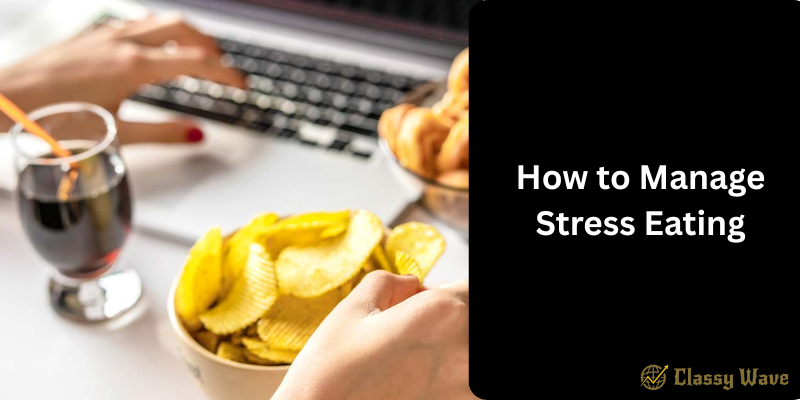How to Manage Stress Eating | Classy Wave
We’ve all been there — a stressful day at work or an argument at home, and suddenly, that bag of chips or tub of ice cream becomes irresistible. This is known as stress eating, and while it might provide temporary comfort, it often leaves you feeling worse later. Learning how to manage stress eating is essential for maintaining both your mental and physical health. Let’s explore practical, science-backed ways to stop emotional eating and take back control of your habits.
What is Stress Eating?
Stress eating, also called emotional eating, is when you eat in response to emotions rather than hunger. When you’re stressed, your body releases cortisol — a hormone that increases appetite. This often leads to cravings for high-sugar, high-fat foods that temporarily make you feel better. However, the relief is short-lived, and it can quickly turn into a cycle of guilt, overeating, and more stress.
Why Do We Eat When Stressed?
Understanding the cause is the first step to overcoming stress eating. Here are the most common triggers:
- Emotional comfort: Food releases feel-good chemicals like dopamine.
- Distraction: Eating can temporarily take your mind off problems.
- Routine: You may associate food with relaxation or rewards.
- Lack of awareness: Sometimes, you eat simply out of habit, not hunger.
Recognizing your emotional triggers helps you find healthier ways to cope.
Recognize the Signs of Stress Eating
Before managing it, you need to identify it. Common signs include:
- Eating even when you’re not physically hungry
- Craving specific comfort foods (like sweets or salty snacks)
- Feeling guilty or ashamed after eating
- Eating mindlessly while watching TV or scrolling your phone
If these sound familiar, don’t worry — awareness is the first step toward change.
Differentiate Between Physical and Emotional Hunger
Physical hunger builds gradually and can be satisfied by any food, while emotional hunger comes suddenly and demands specific comfort foods.
Here’s a quick way to tell the difference:
- Physical hunger: Grows slowly, satisfied by a balanced meal, no guilt after eating.
- Emotional hunger: Appears instantly, craves certain foods, guilt follows afterward.
Pause for a moment before eating and ask yourself — “Am I really hungry, or am I just stressed?”
Healthy Strategies to Manage Stress Eating
1. Find Alternative Stress Relievers
Instead of reaching for food, try other ways to calm your mind:
- Go for a walk or light jog
- Listen to music or meditate
- Write in a journal
- Call a friend and talk it out
- Practice deep breathing or yoga
These activities help reduce stress hormones naturally without adding calories.
2. Keep Junk Food Out of Reach
Out of sight, out of mind! Don’t keep chips, candy, or soda within easy reach. Instead, stock up on healthy snacks like:
- Fresh fruits
- Greek yogurt
- Nuts and seeds
- Air-popped popcorn
If healthy food is the only option available, you’re more likely to make a better choice when cravings hit.
3. Eat Mindfully
Mindful eating helps you stay aware of what and how much you’re eating.
Tips for mindful eating:
- Sit down at a table — no screens or distractions.
- Chew slowly and enjoy every bite.
- Stop eating when you feel satisfied, not stuffed.
- Rate your hunger before and after meals.
The goal is to create a conscious connection between your mind and your plate.
4. Manage Stress Before It Manages You
Prevention is always better than cure. Regular stress management practices can reduce emotional eating episodes:
- Maintain a consistent sleep schedule
- Exercise regularly — even 20 minutes daily helps
- Practice mindfulness or meditation
- Take breaks during work to prevent burnout
When stress levels are lower, cravings for comfort food decrease naturally.
5. Keep a Food and Mood Journal
Writing down what you eat and how you feel helps identify emotional patterns. Over time, you’ll notice triggers — such as boredom, anxiety, or loneliness — that lead to overeating. Once you know your patterns, you can plan healthier responses in those moments.
6. Don’t Be Too Hard on Yourself
Everyone indulges sometimes — and that’s okay! Be kind to yourself if you slip up. Instead of guilt, focus on progress. Remind yourself that change is gradual and that one bad day doesn’t define your journey.
Healthy Food Swaps for Stress Eating
When cravings strike, opt for these satisfying yet nutritious alternatives:
- Instead of chips → try roasted chickpeas or nuts
- Instead of ice cream → have frozen yogurt with fruits
- Instead of candy → eat a banana or apple slices with peanut butter
- Instead of soda → drink infused water or green tea
These swaps provide comfort without sabotaging your health goals.
Seek Professional Support if Needed
If stress eating is affecting your weight, mood, or health, consider talking to a therapist, nutritionist, or counselor. Cognitive Behavioral Therapy (CBT) is highly effective in addressing emotional eating by helping you change negative thought patterns.
Build a Positive Relationship with Food
Food should nourish your body, not control your emotions. Develop a balanced mindset — enjoy your favorite treats occasionally, but don’t use food as your primary coping mechanism. Celebrate food as part of self-care, not self-sabotage.
Conclusion
Learning how to manage stress eating isn’t about strict dieting or avoiding your favorite snacks. It’s about understanding your emotions, building mindful habits, and finding healthier ways to relieve stress. With patience and consistency, you can regain control of your eating habits and improve both your mental and physical well-being. Remember — it’s progress, not perfection, that matters.







